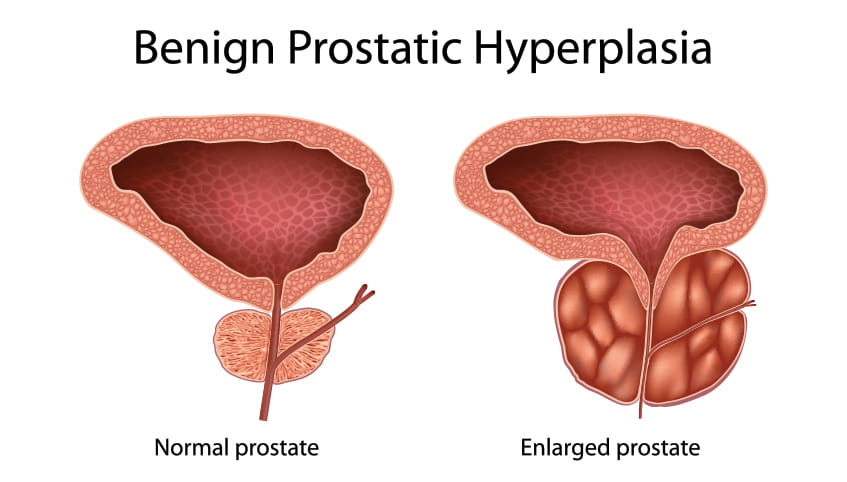Enlarged Prostate
As men age, the prostate enlarges or tightens resulting in symptoms such as difficulty urinating, frequent urination, bladder stones, recurrent urinary tract infections or blood in the urine. Enlarged prostate, also called benign prostatic hyperplasia (BPH), is a common diagnosis. More than half of men will have BPH by age 51 and up to 90% of men will develop BPH symptoms after age 80.
BPH can significantly impact your quality of life, but The University of Kansas Health System can help. With a nationally renowned urologic care team at an academic medical center, our patients and collaborating referral partners have access to the entire spectrum of BPH treatment options.
This includes all treatment modalities and comprehensive care and management for BPH, including the most specialized laser procedures you will not find available elsewhere in the region. We also offer the newest therapies for enlarged prostate, like aquablation, to men in the Kansas City metro region and throughout the state of Kansas and western Missouri.
What is BPH?
A man’s prostate naturally grows in size with age. The first time this occurs is early in puberty, and the second time this occurs is in the mid-20s. Prostate growth continues throughout a man’s life. While the prostate will typically stay the size of a walnut, it can continue to grow over time and push down on your urethra, which is the tube that moves urine from the bladder outside of the body. This condition is called enlarged prostate or BPH.
BPH is a chronic progressive condition. Although it’s not considered dangerous since it is not a precursor to cancer, BPH symptoms can affect quality of life. If BPH symptoms become severe and remain untreated, they can cause more serious health concerns such as the inability to urinate, urinary tract infections, bladder stones, urinary incontinence and bladder or kidney damage.

We offer a variety of appointment types. Learn more or call 913-588-1227 to schedule now.
Enlarged prostate symptoms and risks
As the prostate enlarges and pushes on the urethra, urinary issues may begin to develop. These symptoms can include, but are not limited to:
- Difficulty starting urination
- Dribbling at the end of urination
- Frequent urination
- Sensation of incomplete emptying of the bladder
- Urine stream that starts and stops
- Waking up at night to urinate
- Weak urinary stream
Call your doctor immediately if you become incontinent and cannot control urination, experience pain or a burning sensation when urinating or discover blood in the urine.
A man’s age has an effect on his prostate. Family history can also play a significant role in the development of BPH.
If a man’s father or brothers have had an enlarged prostate, there is a higher risk that he will develop the same issue. In addition, Caucasian and African American men have a higher risk of experiencing BPH problems compared to Asian men.
Prostate enlargement diagnosis and screening
There is no specific test for an enlarged prostate. Your physician will complete a physical exam, and may also perform other initial tests to diagnose an enlarged prostate:
- A DRE is a digital rectal exam performed by the doctor using a lubricated glove. As the man bends forward or lies on his side, the doctor inserts one finger into the rectum to feel the prostate and determine if it has an abnormal shape or thickness.
- A PSA blood test looks for levels of a protein-specific antigen found only in the prostate gland. This protein should be at a low level for a healthy prostate. Higher levels can indicate an inflammation known as prostatitis, BPH or prostate cancer. African American men and those with a family history of prostate cancer should begin PSA testing at age 40. PSA is routinely tested in all men age 55 to 70.
- A urine test will rule out any infection or other issue.
Your doctor may order some additional tests. Among them are a uroflowmetry test, measuring how fast the urine flows, a PVR or postvoid residual test to determine how much urine is left in the bladder after urination, an ultrasound of the prostate, plus others.

Working together for you
Our doctors collaborate to provide the best care for men with an enlarged prostate.
Enlarged prostate treatment
Treatment options depend on your general health, severity of symptoms and size of the prostate. A number of treatment options are available to help ease symptoms, but it is important to understand the details of each specific treatment and consult with your doctor before making a final decision:
- Aquablation therapy for BPH is the latest minimally invasive, robotic procedure that uses a heat-free water jet to remove prostate tissue with minimal irreversible side effects. Aquablation can be used for small, medium and large glands that traditionally required simple prostatectomy or HoLep. Patients retain sexual function, experience similar longevity of treatment to the gold standard transurethral resection of the prostate, or TURP, and can reduce medication burden. Aquablation therapy generally includes an overnight hospital stay, but the patient can likely return home without a catheter and experiences long-term relief.
- Combination therapy combines two drugs (namely an alpha blocker and an inhibitor) together to relax the bladder muscles and relieve symptoms of BPH.
- Oral medication can improve urine flow and reduce symptoms. While oral medications may be convenient, they may lead to sexual side effects that should be discussed with your provider. Be sure to discuss your BPH medications with other care teams as well, including preparation for outpatient procedures like cataract surgery.
- Prostatic artery embolization (PAE) is a minimally invasive nonsurgical treatment for BPH offered by interventional radiology specialists.
- Rezūm® water vapor therapy is an in-office procedure that uses steam to remove prostate tissue blocking the flow of urine from the bladder.
- Thermotherapy applies heat energy to the prostate tissue.
- The UroLift® system is an innovative treatment for BPH that lifts and holds the enlarged prostate tissue so it no longer blocks the urethra. It does not require heating, cutting or removal of the prostate tissue. The procedure is performed on an outpatient basis and patients often return home the same day without a catheter.
Holmium laser ablation (HoLAP) and holmium laser enucleation of the prostate (HoLEP) are minimally invasive surgical alternatives to the removal of the prostate for long-term resolution of BPH symptoms:
- HoLAP: During a HoLAP procedure, your surgeon will guide a laser to heat and remove any blockages with the aim of improving or resolving any urination symptoms.
- HoLEP: For a HoLEP procedure, a secondary tool is used in conjunction with the laser to cut the excess tissue for removal. Cutting and removing the excess tissue also allows pathologists to examine the sample for prostate cancer if needed.
If other treatment options are not successful, your doctor may recommend prostate surgery.
Prevalence and Treatment of BPH
Richard "Jake" Fantus, MD:
The incidence of BPH increases with age and, while prostate cancer may affect one in eight men, BPH affects up to 50 percent of men by the age of 50. And then almost universally affects men over the age of 70 and 80. Up to 80 percent of men will have some complaints of urination likely due to some growth of their prostate. It's difficult to prevent, your prostate grows as you age. It just depends on how much it grows and whether or not it's causing you symptoms. It's something you should obviously talk to your provider about, whether that's your primary care physician or your urologist. There are things we can do to maybe prevent it from progressing at different rates. In terms of treatment, there are lots of different treatments ranging from simply lifestyle interventions, changing what you you drink or how much you drink at what time. For example, not drinking several hours before night time may decrease the number of times you need to get up to use the bathroom at night. There are medications that either relax the prostate or help actually shrink the prostate. And there are even surgical procedures to help trim the prostate in ways that allow you to urinate more easily. Those things range from the traditional roto-rooter procedure or TURP you may have heard of from your father or grandfather. All the way to newer technologies things, like the aquablation to kind of trim the tissue down.
Why choose us for BPH treatment
- At The University of Kanas Health System we offer all treatment modalities and comprehensive care for BPH, including the most specialized laser procedures not available elsewhere in the region and the newest therapies available to the market.
- From primary care and interventional radiology to urologic leaders active with the American Urologic Association, you have access to the largest multispecialty physician practice in Kansas.
- Our urologic care consistently receives one of the highest patient satisfaction scores at 95%, as reported by Press Ganey. Press Ganey data reports 95% of patients seen by our physicians would recommend our practice to a friend or family member.
- Services are provided by The University of Kansas Hospital – named the No. 1 hospital in Kansas and Kansas City by U.S. News & World Report since the award’s inception. Because we are part of an academic medical center, you have access to the latest and most comprehensive diagnostic and treatment options available and a continuous network of care.
Enlarged prostate FAQ
If you’ve been diagnosed with enlarged prostate or BPH, it’s understandable you have questions about the condition and available treatment options. Our team of skilled urologic disease-specific specialists can walk you through the entire continuum of care from diagnosis through treatment.

Leading research and clinical trials
As part of one of the nation's premier academic medical centers, our care providers are committed to research and scientific discovery through the University of Kansas Medical Center. We can often include our patients in potentially lifesaving clinical trials and treatment options not available anywhere else.







